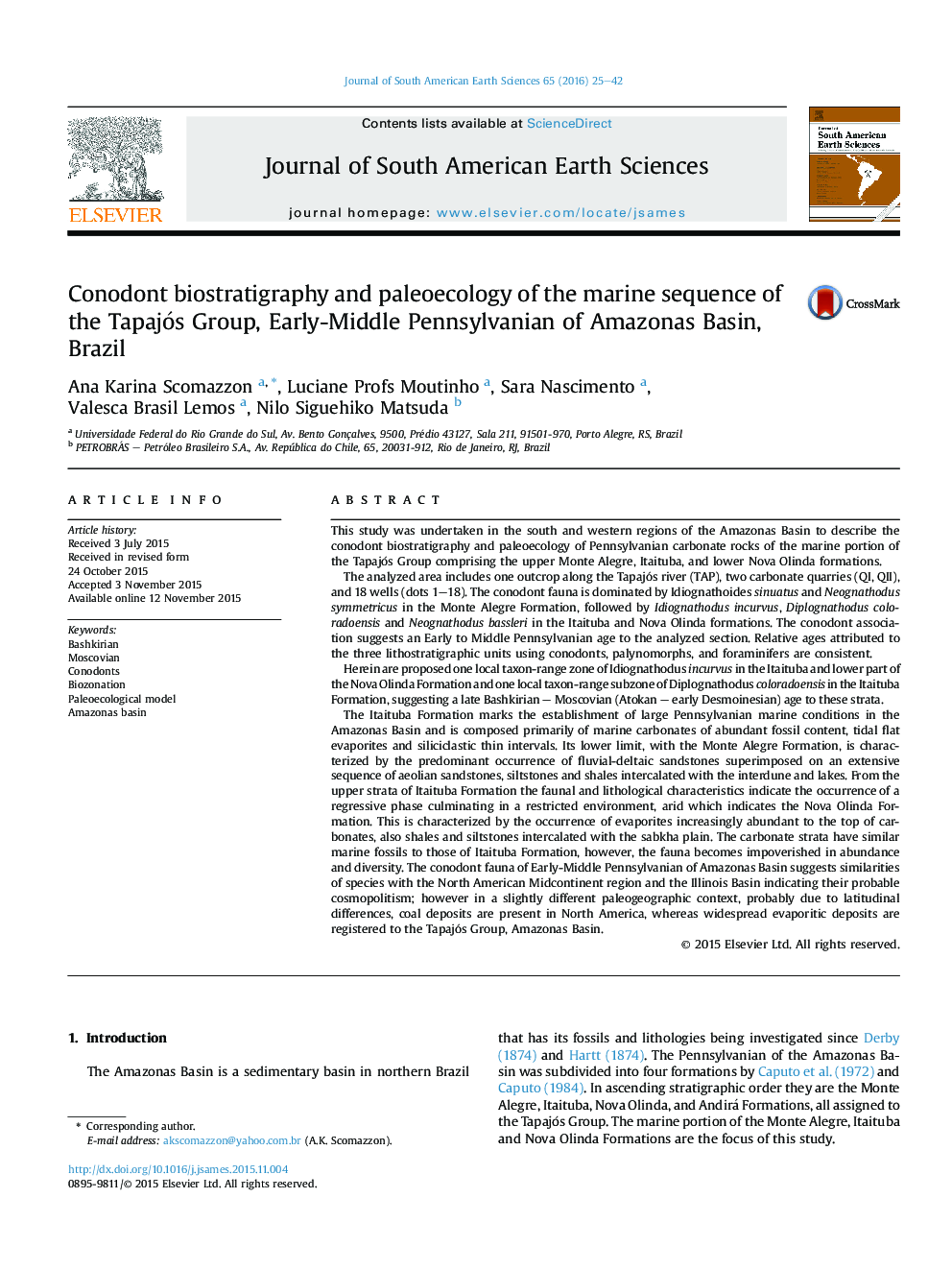| کد مقاله | کد نشریه | سال انتشار | مقاله انگلیسی | نسخه تمام متن |
|---|---|---|---|---|
| 4682023 | 1635145 | 2016 | 18 صفحه PDF | دانلود رایگان |

• Analyzed conodonts from Pennsylvanian marine section of Amazonas Basin.
• Tapajós Group, upper Monte Alegre, Itaituba and lower Nova Olinda formations.
• Conodonts biostratigraphy (late Bashkirian-Moscovian) and paleoecology (marine).
• Idiognathoides sinuatus and Neognathodus symmetricus in Monte Alegre Formation.
• Idiognathodus incurvus, Diplognathodus coloradoensis, Neognathodus bassleri in Itaituba and Nova Olinda formations.
This study was undertaken in the south and western regions of the Amazonas Basin to describe the conodont biostratigraphy and paleoecology of Pennsylvanian carbonate rocks of the marine portion of the Tapajós Group comprising the upper Monte Alegre, Itaituba, and lower Nova Olinda formations.The analyzed area includes one outcrop along the Tapajós river (TAP), two carbonate quarries (QI, QII), and 18 wells (dots 1–18). The conodont fauna is dominated by Idiognathoides sinuatus and Neognathodus symmetricus in the Monte Alegre Formation, followed by Idiognathodus incurvus, Diplognathodus coloradoensis and Neognathodus bassleri in the Itaituba and Nova Olinda formations. The conodont association suggests an Early to Middle Pennsylvanian age to the analyzed section. Relative ages attributed to the three lithostratigraphic units using conodonts, palynomorphs, and foraminifers are consistent.Herein are proposed one local taxon-range zone of Idiognathodus incurvus in the Itaituba and lower part of the Nova Olinda Formation and one local taxon-range subzone of Diplognathodus coloradoensis in the Itaituba Formation, suggesting a late Bashkirian – Moscovian (Atokan – early Desmoinesian) age to these strata.The Itaituba Formation marks the establishment of large Pennsylvanian marine conditions in the Amazonas Basin and is composed primarily of marine carbonates of abundant fossil content, tidal flat evaporites and siliciclastic thin intervals. Its lower limit, with the Monte Alegre Formation, is characterized by the predominant occurrence of fluvial-deltaic sandstones superimposed on an extensive sequence of aeolian sandstones, siltstones and shales intercalated with the interdune and lakes. From the upper strata of Itaituba Formation the faunal and lithological characteristics indicate the occurrence of a regressive phase culminating in a restricted environment, arid which indicates the Nova Olinda Formation. This is characterized by the occurrence of evaporites increasingly abundant to the top of carbonates, also shales and siltstones intercalated with the sabkha plain. The carbonate strata have similar marine fossils to those of Itaituba Formation, however, the fauna becomes impoverished in abundance and diversity. The conodont fauna of Early-Middle Pennsylvanian of Amazonas Basin suggests similarities of species with the North American Midcontinent region and the Illinois Basin indicating their probable cosmopolitism; however in a slightly different paleogeographic context, probably due to latitudinal differences, coal deposits are present in North America, whereas widespread evaporitic deposits are registered to the Tapajós Group, Amazonas Basin.
Figure optionsDownload as PowerPoint slide
Journal: Journal of South American Earth Sciences - Volume 65, January 2016, Pages 25–42